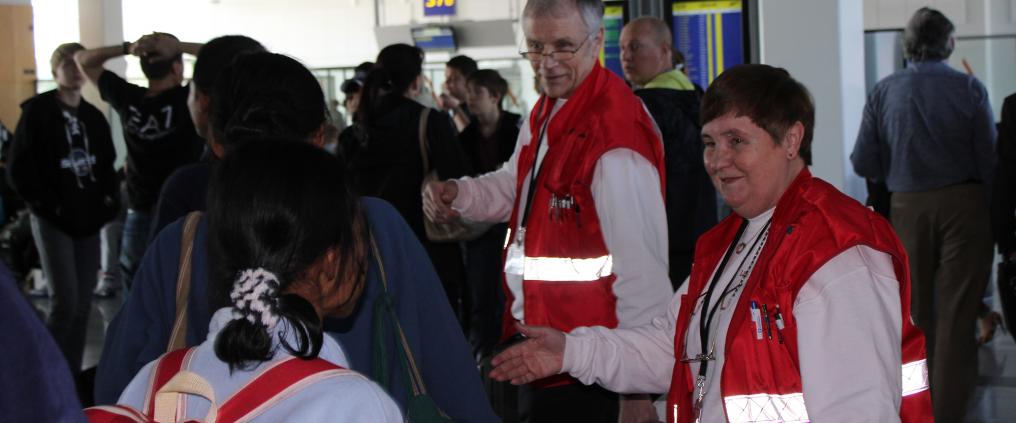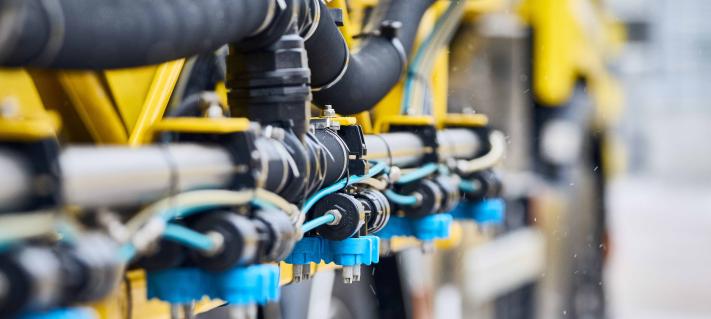Helsinki Airport is not just a tourist travel point. For quota refugees chosen to live in Finland, the airport is the first entry point to a new life. Finnish Red Cross volunteers are present at the gates to receive the newcomers and make sure they are given a humane welcome.
Finnish Red Cross planner Tiina Salmio and long-time volunteer Stig Bergström share interesting facts about receiving refugees.
The Finnish Red Cross has been ensuring humane reception for refugees since 1973.
”The Finnish Red Cross has been involved in receiving refugees since the first quota refugees arrived in Finland in 1973 from Chile, escaping Pinochet’s military junta,” Tiina Salmio explains.
”Our basic task is still the same: Volunteers make sure refugees’ entry into the country is safe and humane. They support the refugees through airport formalities and help them find connecting flights or buses. The Red Cross works to aid people in the most vulnerable position across the globe.”
In 2016, quota refugees arriving to Finland were, for example, Syrians, Somalians, Congolese and Afghans.
Quota refugees have a home in Finland and don’t go to reception centers.
Reception at the airport is for quota refugees, not asylum seekers. The difference being that quota refugees have been granted refugee status by UN’s international refugee organization UNHCR and belong to a yearly quota the Finnish parliament has decided to accept into Finland on humanitarian grounds. These refugees are in a vulnerable position in their own country.
"Volunteers make sure refugees’ entry into the country is safe and humane."
”People often confuse quota refugees and asylum seekers,” Stig Bergström says. “The refugees we receive have been ’handpicked’ by the Finnish immigration agency Migri and they already have a home in Finland.”
Quota refugees have an apartment in a receiving municipality in Finland, to where they are directed from Helsinki Airport.
In 2015, a little over a thousand quota refugees were received by 51 municipalities around the country.
Volunteers help the newcomers in registration and finding their connecting flight or bus.
In practice, Red Cross volunteers and a translator meet the incoming refugee at the gate or in the arrivals hall, welcome them and guide them to the border control officials to be registered. There are snacks and water in the waiting room and while waiting for registration, the refugees can ask the volunteer – with the help of the translator – about Finland and their new hometown or rest for a moment before their connecting flight or bus ride.
"As these people are in Finland for the first time, and have not necessarily travelled a lot, they often need our help in finding their way around the airport and taking care of formalities."
”The volunteers sometimes help the refugees tend to their children, if they have a lot of luggage or are terribly tired from the trip,” Salmio says.
After the registration procedure, the volunteers guide the refugees to their next travel connection.
”As these people are in Finland for the first time, and have not necessarily travelled a lot, they often need our help in finding their way around the airport and taking care of formalities. We offer safety and support,” Stig Bergström continues.
Reception focuses on the start of a new life.
The volunteers are refugees’ first contact in their new home country and a warm reception is the first step into successful acculturation.
”We tend not to ask the refugees about their past, but focus more on practical issues and their future life in Finland. They have already been given basic information about Finland in their country of origin, but we answer questions and try to make them feel welcome,” Bergström explains.
Volunteers are mainly Finnish pensioners.
Most of the volunteers receiving refugees at Helsinki Airport are pensioners, as the work happens during working hours and requires a flexible schedule as flights may be delayed by hours. The volunteers must also commit to the work for several years at a time, as permits at the airport are personal and paid for by the Finnish Red Cross.
"For me and my wife, who is also a volunteer, helping and doing good for others are essential in life"
Currently, 17 volunteers work at Helsinki Airport, around two to three days a week. During June, July and August, there’s less work as fewer refugees arrive during the summer months.
Though volunteers don’t receive pay for their work, helping and encountering people are rewarding in themselves.
”The work is really enriching spiritually; the gratitude and warmth of these refugees really move your heart. For me and my wife, who is also a volunteer, helping and doing good for others are essential in life,” Bergstrom sums up.
Picture: Milla Mäkilä / Finnish Red Cross



